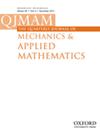A sphere in a second degree polynomial creeping flow parallel to a plane, impermeable and slipping wall
IF 0.8
4区 工程技术
Q3 MATHEMATICS, APPLIED
Quarterly Journal of Mechanics and Applied Mathematics
Pub Date : 2016-11-01
DOI:10.1093/QJMAM/HBW010
引用次数: 4
Abstract
The motion of a solid and no-slip spherical body immersed in a Newtonian liquid near a motionless, plane and impermeable slip wall is investigated, in the creeping flow approximation, using on the wall the Navier slip boundary condition. The considered cases are as follows (i) a sphere either translating or rotating parallel to the wall in a quiescent liquid; (ii) a sphere either held fixed or freely-suspended in a modulated, linear or quadratic ambient shear flow. For each case, the velocity and pressure fields about the sphere together with the associated physical quantities whenever relevant (the force, torque, non-zero stresslet component on the sphere and its translational and angular velocities) are expressed in bipolar coordinates as infinite series, the coefficients of which are governed by an infinite linear system. This system is solved numerically by first truncating at an order depending on the relevant quantity and on the sphere location and wall slip length and then applying either a Gaussian elimination or a Thomas’ algorithm for inverting a large tridiagonal matrix. Handy formulae for all key quantities are also derived as asymptotic expansions for a sphere-wall gap that is large compared with the sphere radius. The sensitivity of the computed associated normalized friction factors (force, torque, stresslet) and mobilities (translational and angular velocities) to both the sphere location and the wall slip length are then discussed.一种与平面、不透水和滑动壁面平行的二阶多项式蠕变流球体
在蠕变流动近似下,利用Navier滑移边界条件,研究了固体无滑移球体在靠近不动的、平面的、不透水的滑移壁上浸入牛顿液体中的运动。所考虑的情况如下:(i)一个球体在静止的液体中平行于壁面平移或旋转;(ii)在调制的、线性的或二次的环境剪切流中固定或自由悬浮的球体。对于每种情况,球体的速度和压力场以及相关的物理量(力,扭矩,球体上的非零应力分量及其平动和角速度)在双极坐标中表示为无穷级数,其系数由无限线性系统控制。该系统通过首先根据相关数量和球体位置和壁滑移长度按顺序截断,然后应用高斯消去法或托马斯算法对大型三对角矩阵进行反演来进行数值求解。对于与球半径相比较大的球壁间隙,还可以推导出所有关键量的简便公式。然后讨论了计算出的相关归一化摩擦系数(力、扭矩、应力)和可动性(平动速度和角速度)对球体位置和壁面滑移长度的敏感性。
本文章由计算机程序翻译,如有差异,请以英文原文为准。
求助全文
约1分钟内获得全文
求助全文
来源期刊
CiteScore
1.90
自引率
11.10%
发文量
14
审稿时长
>12 weeks
期刊介绍:
The Quarterly Journal of Mechanics and Applied Mathematics publishes original research articles on the application of mathematics to the field of mechanics interpreted in its widest sense. In addition to traditional areas, such as fluid and solid mechanics, the editors welcome submissions relating to any modern and emerging areas of applied mathematics.

 求助内容:
求助内容: 应助结果提醒方式:
应助结果提醒方式:


